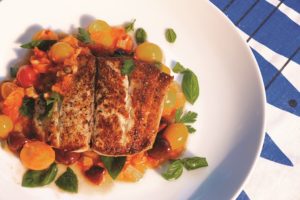Bluefish are misunderstood on the mainland. Detractors there moan about them being “too oily” or “fishy.” But Cape Codders wait hungrily for this season. What we know is that, handled right, bluefish are extremely fine eating.
In high summer, I make a near-daily pilgrimage to Hatch’s, behind Wellfleet’s town hall. On a recent trip I knew the season was on when I saw a truck emblazoned with a familiar logo. Behind the wheel was Tom Smith, captain of the F/V Sea Wolf. He is the fisherman who has been feeding my love of bluefish for over two decades.
When I asked him about the catch, Smith, a.k.a. Dr. Bluefish, as his T-shirt tagged him, jumped into his flatbed and opened an oversize blue cooler. The fish inside were magnificent, with vibrant golden eyes, ruby gills, and shimmering sea green-indigo skin. His blues were “stiff as a board,” not from freezing, he explained, but in rigor, a true mark of fastidious handling. I was an instant fan girl.

Freshness rules when it comes to blues, which is why they don’t have wide distribution off Cape. Also, the fishery is primarily recreational, with only 20 percent of the catch landed commercially.
Blues are feisty, with nasty knife-like teeth and voracious appetites (even for their own kind). They’ll put up a fight that anglers love. They “strike like a blacksmith hammer,” wrote John Hersey in his 1988 classic, Blues.
Smith has spent the past four decades fishing for blues. His family moved to Orleans from Connecticut when he was 10 years old and he got his first fishing job when he was 12, working part time on Stu Finlay’s charter boat, the Empress, out of Rock Harbor.
He no longer catches blues with a rod and reel, except when testing whether the fish are biting. Over the years, he has refined a technique he first saw practiced in Florida, where he worked on crews for several years right after he graduated from Cape Cod Tech. He calls it strike netting as opposed to gillnetting, because the fish are pulled up and removed from the netting right away.
Smith came back home to focus on fishing for blues here in 1981. He starts the season fishing near Chatham, not far from his home port in Hyannis, and follows the fish, so that by July he’s fishing just outside Provincetown Harbor.
Blues are eating machines, Smith says: “You want to see a feeding frenzy before a set.” He looks for a slick on the water and sniffs the air for “a watermelon-like aroma” that confirms they’re at it. Then he guides his boat to set the net in a large circle, while the crew makes a racket to drive the fish into the net.
The fish are dispatched immediately — he bleeds them with a cut to the throat — then they’re gutted and cleaned and slipped into a slurry of ice water within minutes. This is a game changer from his old charter days.
“We would catch beauties, but just toss them into coolers without ice,” Smith recalls. “By the time we got them off the boat and filleted them, the flesh was like mashed potatoes.”
Smith is committed to delivering the freshest fish, so he drives directly from the boat to the markets — no middleman. The proof is in the fish case: the flesh is firm and translucent steely blue and smells sea sweet — nothing fishy about it.
His methods are a big reason people on the Outer Cape seek out the blues when they’re in season. Smith tells of one late delivery after a slow day — when he pulled in at Hatch’s, he says, “There was a line out the door and folks started clapping!”
Bluefish are high in omega-3 fatty acids, something we need to eat more of. But sidestepping the sensible “it’s-good-for-you” bit, they’re also rich, and, as cooks know, fat equals flavor. Think bacon. It’s a fish that can be enjoyed in so many ways: grilled, broiled, or smoked, and you can even fry the skin into crisp chips.
When I want things really easy, I season a fillet with salt and lots of pepper and wrap it in a foil pack with a squeeze of lemon or splash of wine and a bit of butter or olive oil, then cook it outside on a moderate grill.
Blues stand up to assertive flavors. When I add sliced jalapenos, garlic, scallions, and lime juice to the package, and finish it with lots of cilantro at the end, guests are ecstatic. “What did you do? That bluefish was amazing!” I take it in, even though I know all credit goes to Tom Smith.
The recipe here is one for an indoor cooking day. I love sautéing bluefish to give it even sear. In high summer, when real tomatoes are in, I default to a compote inspired by pasta puttanesca that serves at once as a kind of sauce and side. Bluefish welcomes capers’ and olives’ bold acidity.
This uses a genius technique for quick tomato sauces: grating. Trim a disk off the tomato bottom and rub the cut end over a grater’s large holes. The tomato purees off the skin, which flattens without going through the holes. Use a big juicy tomato for the saucy part and a multicolored mix of small tomatoes for a bright complement.
Sautéed Bluefish With Tomato, Olive, and Caper Compote
Serves 4

For the compote:
2 ripe tomatoes, or about a one-pound mix of large and small
2 Tbsp. extra-virgin olive oil
½ medium onion, diced
1 rib celery, with leaves, diced
3 cloves garlic, minced
Generous pinch red pepper flakes
8 olives, pitted and chopped
1 Tbsp. capers, with brine
2 to 3 Tbsp. chopped flat-leaf parsley, basil, or mint
For the bluefish:
2 Tbsp. extra-virgin olive oil
1 bluefish fillet, 1½ to 2 lbs.
Kosher salt and fresh-ground black pepper
Make the compote first. Slice a round off the bottom of a large tomato. Rub the cut side over the big holes of a grater, letting the pulp and juices fall into a bowl. Grate until all you have left is the skin and discard it. Dice or halve remaining tomatoes.
Heat the olive oil in a skillet over medium heat. Add onion, celery, garlic, and pepper flakes, cook, stirring occasionally, until soft, about 5 minutes. Add tomatoes, olives, and capers; cook over high heat, stirring, until thickened, about 3 minutes. Off heat, add the herbs. Reheat or serve at room temperature.
Now sear the fish. If you cook on a griddle, a full fillet will work. If not, cut the fish into four portions.
Put a large skillet on medium-high heat. Season fish generously with salt and pepper. Add oil to the skillet, and, when it is hot, place the fish in the pan, skin side up. Cook about 5 minutes — you want it about three-quarters of the way done. Adjust the heat to medium and flip the fish carefully, cooking until the fish cooks through, 1 to 2 minutes more.
Spread compote on a platter and top with the fish.



